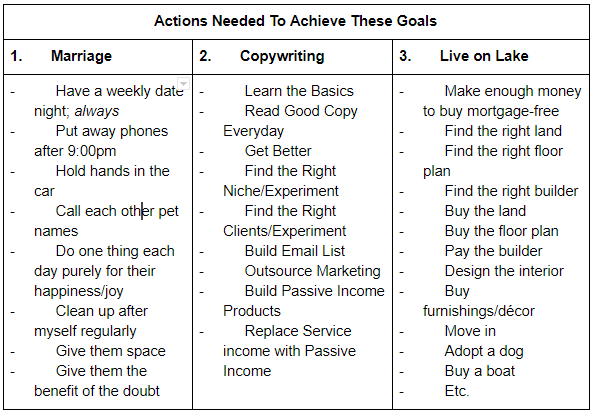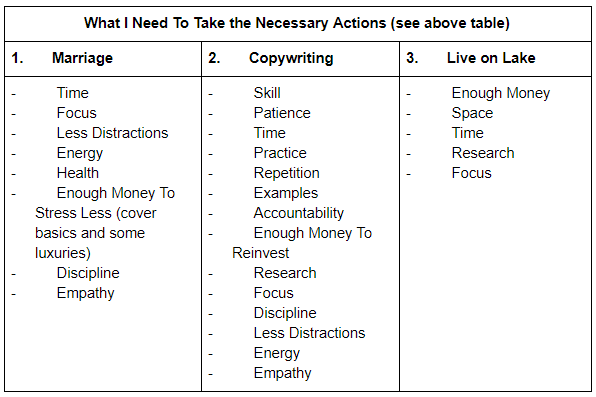It’s a New Year!
(Provided you subscribe to the concept of time as we measure it and all that jazz…)
That means, it’s time to hear out everybody’s resolutions…
Then watch them very casually and quietly abandon said resolutions two to six weeks in.
You’ve probably seen this all around the internet, but studies have shown that 92% of New Year’s goals go unachieved.
When you look at it like that, it’s actually a very sobering, sad time of year.
But here at The No Pants Project we don’t subscribe to that sort of low-vibe wallowing.
We’re here to invite you to undertake a different method of goal-setting this year, the kind that makes you a goal-getter instead of goal-setter-then-forgetter.
(Because we still believe good goals are some of the most powerful motivators and markers along your journey of personal success.)

Quiet Goals (Or How to Join The 8%)
“New Year, New Me!”
“2019 is Going to Be My Year – Watch Me Rise To The Top!”
“This is the Year I Get a Victoria’s Secret Model Body!”
Well maybe not that last one, in particular, since that’s one of my younger self’s very loud, very unrealistic New Year’s resolutions.
But the rest of those probably sound pretty familiar to you, don’t they?

They’re the type of goals people broadcast all over social media and yell about in the later hours of the New Year’s celebrations.
They’re big.
They’re loud.
They’re unrealistic, and quite frankly, completely thoughtless.
Pia Silva writes for Forbes, “Many people fail to achieve their goals because they identify an outcome without also identifying the underlying motivation of that outcome.”
So we need to do something different.
What I’m about to suggest is very unexciting – at least on the surface.
Because I’m about to suggest that you set seemingly tiny goals; small, micro-goals that are based on elements of simplicity and minimalism but have high impact potential.
People are often setting goals based on a feeling of “lack” or dissatisfaction with themselves as they are.They use these goals to try to precipitate a massive change in fundamental aspects of their lives or personalities.
This is a problem, because as Mary Jaksch, founder of GoodlifeZEN and WritetoDone.com, writes:
“For whatever reason, we tend to focus on our goals with long-term vision but short-term expectations. So we wind up subconsciously anticipating long-term level results right now. Sounds like a recipe for disaster, doesn’t it? If nothing else, it’s a great way to set yourself up for failure and all the negative emotions that accompany it.”

Instead, quiet goals are about small, intensely individual goals that aren’t meant to be “Instagram-worthy.”
Rather they facilitate deep shifts and impact in your life by helping you achieve genuine, individual goals of growth and self-improvement.
Examined Existence explains, “Micro goals are not about what you are going to do in the future or what you are going to do later, they are about what you are going to do now. And that sense of urgency and the proceeding feeling of accomplishment does a great deal of good for the psyche by providing needed momentum and motivation.”
In fact, I’d suggest you steer clear of sharing your goals on social media, even for accountability purposes, because social media is much more likely to have negative effects on your goals by encouraging comparison to unrealistic “highlight reels” of other people’s lives.
What I call “quiet goals” take the micro goal approach with a focused effort on encouraging and creating more simplicity, focus, and quiet in the usual chaos of our lives.
I want you to set goals that quiet the parts of your mind usually focused on scarcity, lack, and dissatisfaction.
Some personal examples include:
- Create and protect a space in my home for focused, productive work.
- Keep more plants in the house.
- Leave my phone in another room more often.
- Write an email every day – good or bad, short or long.
- Practice saying “no”.
How did I come up with these, and how are these tiny things going to create massive impact in my life?
Read on, young padawan.
There are 5 steps to creating Quiet Goals.
Step 1: Envision Your Personal, Ideal Day

What does your ideal day look like?
What does it smell like?
Where are you?
Who is with you?
What do you do for a living?
How often and for how long do you do it?
How does it make you feel?
Get specific.
Having a clear end point in mind makes it that much easier to work backwards, breaking down the steps you need to take to get there until you end up with tiny, relatively effortless steps you can use to move steadily closer to your ideals.
“Since those steps felt rather small, your brain says, ‘Let’s keep doing that.’ Whereas when we do a huge goal, we can sustain it for a month or so, but then it feels like it’s not worth the reward,” Joe Sanok, owner of Mental Wellness Counselling, explains.
Step 2: Map Out a Plan of Big Steps You Need to Take to Make Your Ideal Day a Reality

All of the questions in the first step are crucial to getting the clearest possible, most inspiring vision of your Grand Goal, but some of them are more dependent on others.
For example, where you are, what it smells like, and what it looks like very likely rely on you having enough time, money, energy and other resources to create your ideal environment.
In other words, they rely on you getting clear on the answers to what you do for a living, how often and how long you do it, and how it makes you feel.
Your method of creating your environment is dependent on you doing something that provides enough financially without burning you out physically or mentally.
And, most importantly, knowing who is with you in the most ideal of your days sets the compass for your overarching priorities, which are the relationships critical to filling your ideal day with happiness and love.
Knowing who is with you is critical for determining how much time you have left after taking care of those relationships to work on whichever business or job you choose, and should narrow down which kinds of work are ideal for you.
For example, you might come out of this exercise with a plan that looks something like this:
- Maintain and Improve Marriage
- Become a Copywriter
- Build a Home on a Lake in X State/City
These are great goals and guides, but they are giant when it comes to trying to fulfill them.
“The average person has so many competing priorities that this type of approach is doomed to failure. Essentially, shooting for the moon can be so psychologically daunting, you end up failing to launch in the first place,” Dan Diamond writes for Forbes.
That’s where Step 3 comes in.
Step 3: Break Down the Big Steps Into Smaller Steps – What Actions Do You Need to Take to Achieve Each Bigger Step?
You might want to put it in a chart that looks something like this, to keep it all in order for yourself:

Step 4: Take Those Smaller Steps and Ask Yourself What You Really Need to Enable Yourself to Actually Take Those Specific Actions
This is where micro-goals start to become “quiet goals”.

Instead of creating a to-do list of goals that, even when small, can start to feel exhausting or overwhelming (at least in my case), I’ve found it personally helps to set goals that provide the types of spaces, feelings, and mindsets I need in order to take action.
I go deeper and examine what mental clarities and resources are missing right now, that would improve the way I show up to my larger goals and turn those goals into a plan instead.
You can create another chart for this, and it might look something like:

Step 5: Dig Deep Into The Things You Need and Find the Simplest Ways For You To Give Them To Yourself, Over Time
What you might notice is that the things you genuinely need to make these changes are slightly more intangible, and are often similar across the board.
Because of this, you can whittle down your goals to things that will help you make progress on these softer, more intangible skills, and focus on the ones that will benefit your goals across the board to make more progress in all aspects of your aspirations.
Now, when we come back to my example goals, it becomes easier to see how these small goals will have big benefits for moving me toward my various goals:
1. Create and protect a space in my home for focused, productive work.
This is critical for me to be able to focus and build copywriting skills, which in turn allow me to earn more money in less time and free up time, energy, and focus for working on my marriage and making financial progress toward my dream of living on a lake.

2. Keep more plants in the house.
Studies have shown that having plants in the house helps to improve mood, energy, and productivity.
They also keep the air cleaner, which helps improve general air quality as well as sleep quality, thus improving my health, my physical ability to work on my goals, and my overall energy.
3. Leave my phone in another room more often.
Across the board I need more focus and less distractions to work toward my goals, so leaving my phone in another room is a small step that allows me more mental space to work on my goals.
Studies have shown that just having your phone in the same room is enough to distract you and pull you out of flow.
“Merely having a phone within reach makes it harder to focus because a percentage of the brain has to actively work to not pick up or use the device,” Inc.com reports.
By leaving my phone in another room more often, I’m more focused at a deeper level on the tasks I’m working on or the people I’m connecting with.
4. Write an email every day – good or bad, short or long.
Perfecting my craft is crucial to my ability to earn more in less time with less stress, freeing me up to focus on my core relationships and allowing me to achieve my financial goals faster.
To do this, I need to commit and build discipline when it comes to writing something relative to my craft every day for practice. An email is short (and also extraordinarily valuable to my clients) and is a perfect, small commitment to pay dividends.
5. Practice saying “no”.

This relates to all my goals. Saying no to opportunities that aren’t right or are just distractions.
Saying no to procrastinating or wasting time I could spend bettering my craft or working on my relationships (or unwinding to allow me to do better at both).
Saying no to spending money on things that don’t move me toward my goals in some way.
Saying no to a third donut to protect my health, etc.
The stronger I become at standing my ground with myself and others, the faster I will move toward and achieve my goals.
As an example of the way saying “Yes” to even one small wrong thing can lead you to wind up entirely off course, James Altucher, author of The Power of Saying No writes “When you have a tiny, tiny piece of crap in the soup, it doesn’t matter how much more water you pour in and how many more spices you put on top. There’s crap in the soup.”

To Sum Up
Goals we set at this time of year often speak to a certain sense of “lack” and “dissatisfaction” with ourselves, and they tend to become grand statements of an intention to be something other than who we are.
When we say we want to get in shape, we often aren’t envisioning ourselves, but somebody else with the body we wish we had.
When we say we want to be successful, we’re thinking about the Jones’ next door or somebody we saw on Facebook, instead of considering more deeply what success means to us, uniquely.
Quiet goals urge us to consider who we are and what we want at a deeper level through the process of whittling down our grand ideas and schemes into tiny, simple goals that will enable us to achieve more and become better, and turn our larger goals into solid plans we are capable of executing.
To set quiet goals for yourself, follow these five steps:
- Envision your personal, ideal day in as much detail as possible to create an end goal, or grand goal, for yourself.
- Map out a plan of big steps you need to take to make your ideal day a reality by asking yourself what sorts of things you need to achieve to realize your end goal.
- Break down the big steps into the smaller actions you need to take to achieve each bigger step. For example, if a big step was “Become a successful copywriter,” write down all the actions you need to take to do so.
- Take those smaller steps and ask yourself what you really need to ensure you’re capable of following through on the actions you need to take. Do you need a specific space, time, more energy or better health? These will be broader, slightly more intangible things that are often similar across the goals.
- Dig deep into the things you need and find the simplest ways for you to give them to yourself, over time. If you need more time, you can create the quiet goal of removing all games from your phone and keeping it free from extra time-wasters, or a goal of using Facebook less.
We Can Help
Ready to keep going deeper, discover your unique value, and build a business that shares it with the world while freeing you to realize your grand goals?
The No Pants Project might just be the place for you.













